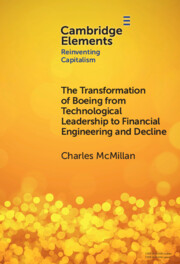Element contents
The Transformation of Boeing from Technological Leadership to Financial Engineering and Decline
Published online by Cambridge University Press: 14 November 2024
Summary
- Type
- Element
- Information
- Online ISBN: 9781009394734Publisher: Cambridge University PressPrint publication: 05 December 2024
References
- 3
- Cited by

